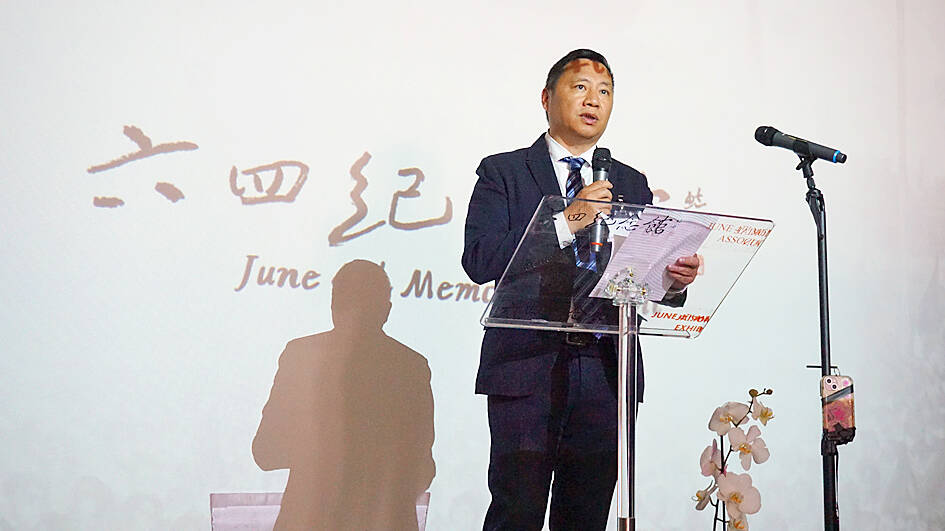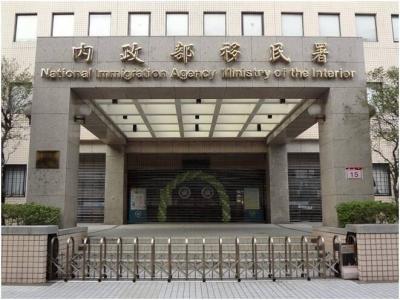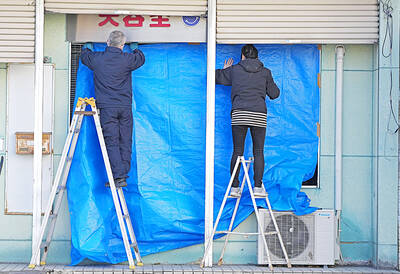A museum commemorating China’s violent crackdown on pro-democracy protests in 1989 opened on Monday in Los Angeles, museum director Wang Dan (王丹) said.
“Commemorating June 4th is not just about mourning and denunciation, it’s also a continuation,” Wang said. “The spirit of ’89 is about holding on to hope for social change.”
The June 4th Memorial Museum, which marks the day Chinese People’s Liberation Army troops opened fire on unarmed protesters in central Beijing, was originally based in New York, but relocated to Los Angeles due to rising rents, Wang said.

Photo: CNA
He added that the move would help bring this part of Chinese history to local communities from China, Taiwan and Hong Kong.
Wang, a student leader during the 1989 movement, was imprisoned by Chinese authorities before moving abroad and earning a doctorate from Harvard University.
In an interview with the Central News Agency, Wang said the greatest challenge in China today is the younger generation’s “disappointment and despair” about their country.
He said he hopes the spirit of the 1989 movement can rekindle a sense of hope and possibility for change.
Located in El Monte, a city of about 100,000 in eastern Los Angeles County, the June 4th Memorial Museum displays photographs and artifacts from the 1989 pro-democracy movement.
One exhibit features a letter sent to Wang by Liu Xiaobo (劉曉波), a Chinese academic who received the 2010 Nobel Peace Prize for his human rights advocacy, while Wang was imprisoned at age 21.
Wang said the museum aims to be more than a static display, but serve as a “vibrant cultural space,” hosting concerts, film screenings and community events to promote cultural and intellectual exchanges.

A small number of Taiwanese this year lost their citizenship rights after traveling in China and obtaining a one-time Chinese passport to cross the border into Russia, a source said today. The people signed up through Chinese travel agencies for tours of neighboring Russia with companies claiming they could obtain Russian visas and fast-track border clearance, the source said on condition of anonymity. The travelers were actually issued one-time-use Chinese passports, they said. Taiwanese are prohibited from holding a Chinese passport or household registration. If found to have a Chinese ID, they may lose their resident status under Article 9-1

Taiwanese were praised for their composure after a video filmed by Taiwanese tourists capturing the moment a magnitude 7.5 earthquake struck Japan’s Aomori Prefecture went viral on social media. The video shows a hotel room shaking violently amid Monday’s quake, with objects falling to the ground. Two Taiwanese began filming with their mobile phones, while two others held the sides of a TV to prevent it from falling. When the shaking stopped, the pair calmly took down the TV and laid it flat on a tatami mat, the video shows. The video also captured the group talking about the safety of their companions bathing

PROBLEMATIC APP: Citing more than 1,000 fraud cases, the government is taking the app down for a year, but opposition voices are calling it censorship Chinese Nationalist Party (KMT) Chairwoman Cheng Li-wun (鄭麗文) yesterday decried a government plan to suspend access to Chinese social media platform Xiaohongshu (小紅書) for one year as censorship, while the Presidential Office backed the plan. The Ministry of the Interior on Thursday cited security risks and accusations that the Instagram-like app, known as Rednote in English, had figured in more than 1,700 fraud cases since last year. The company, which has about 3 million users in Taiwan, has not yet responded to requests for comment. “Many people online are already asking ‘How to climb over the firewall to access Xiaohongshu,’” Cheng posted on

A classified Pentagon-produced, multiyear assessment — the Overmatch brief — highlighted unreported Chinese capabilities to destroy US military assets and identified US supply chain choke points, painting a disturbing picture of waning US military might, a New York Times editorial published on Monday said. US Secretary of Defense Pete Hegseth’s comments in November last year that “we lose every time” in Pentagon-conducted war games pitting the US against China further highlighted the uncertainty about the US’ capability to intervene in the event of a Chinese invasion of Taiwan. “It shows the Pentagon’s overreliance on expensive, vulnerable weapons as adversaries field cheap, technologically